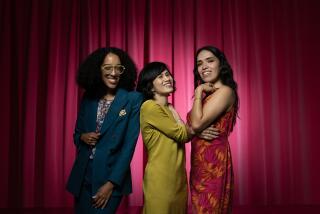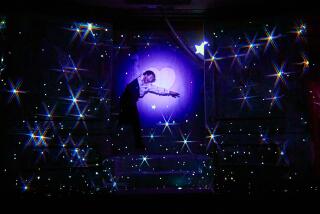Modern life, so stressful
What toll does progress take on the human body and psyche? That’s the question fueling “monumental,” an explosive multimedia work from Canada’s critically acclaimed experimental dance company the Holy Body Tattoo, known for its extreme choreographic reflections on the stresses and strains of urban culture.
The piece, created by co-artistic directors and choreographers Noam Gagnon and Dana Gingras, makes its U.S. premiere Friday and Saturday at UCLA’s Royce Hall as part of the UCLA Live series.
Featuring the company’s signature movement -- repetitive, often violent -- that the Edmonton Journal called “a high-impact metaphor for the broader implications of the work,” “monumental” includes text excerpts from conceptual artist Jenny Holzer’s “Living” series, stark atmospheric video montages by L.A.-based cinematographer William Morrison, light sculptures and design by Marc Parent, and an iconographic, percussive musical soundscape by Roger Tellier-Craig, Montreal collective Godspeed You Black Emperor and France’s Les Tambours du Bronx.
Its inspiration, Gingras explained in a call from Vancouver, was artist Robert Longo’s 1980s “Men in Cities” series of lithographs depicting the contorted, straining bodies of men and women in business chic. The effect is echoed in the dress and postures of the company’s nine dancers, isolated figures balanced on narrow pedestals, who writhe, slump, sway, crash to the floor to rise and fall again, join and separate.
“It’s an obsessive piece, very driven,” Gingras says. “It deals with negotiations of power. We’re constantly trying to conquer the world, and in our desire for progress we’re like a runaway train.”
The title is lowercase because “we’re looking at the minutiae that makes up our daily lives, a buried accumulation that builds up and overwhelms us.”
The beginning of the creative process began when the dancers, sent to watch people during rush hour, on public transit, going to bars after work, observed “the tics that go by unnoticed, the hair-pulling, head-scratching, hand gestures, rubbing noses, the [revealing] tiny details and actions of everyday life.”
Some of the ambient film projections were shot in Los Angeles with time-lapse photography at rush hour on the overpasses of the south 110 Freeway. “Our hope is that we create a space for reflection about the society we’re living in,” Gingras says, “that will resonate and stay with the audience.”
-- Lynne Heffley
More to Read
The biggest entertainment stories
Get our big stories about Hollywood, film, television, music, arts, culture and more right in your inbox as soon as they publish.
You may occasionally receive promotional content from the Los Angeles Times.










